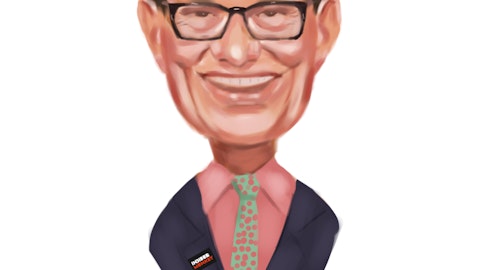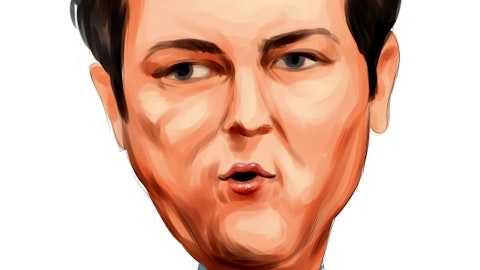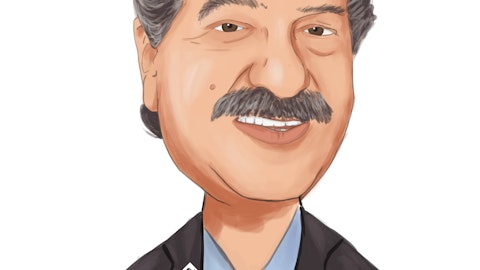Mark Webb: So Daniel, with respect to what’s driving the revenue pricing. We’ve taken strategic price increases. We’ve spoken a little bit about it the last several quarters. Those strategic price increases are sort of in the system now. We also are still experiencing raw material first cost inflation in our goods. And we indicated on the third quarter that those strategic price increases essentially offset the inflationary pressures in our first cost. Our primary driver of inflation is cotton and we’re a heavy user of premium cotton or pima cotton and that is a crop that we’re watching and hopeful will start to come back down from its peak levels in the coming quarters. The other factor we’ve had year to date, it’s worth noting that our business model really has been to become much more focused on the full price promotional line and that has been contributing on a year over year basis AUR or positive increases in AUR above and beyond the ticket price increases.
And Q3, we mentioned on the call that it was the most difficult comparison and that’s because last year was really the first quarter Q3 that we obtained a really low healthy level of full price promos where we want to be. So that year over year gain kind of went away, but now we’re a ticket, full price mix, etcetera, as we continue to move forward that will continue to drive the AUR.
Daniel Lupo: Got it. That’s helpful. And then just looking at the cash balance quarter over quarter, can you maybe talk about some of the puts and takes outside of the margin benefits as you saw year over year? Were there any kind of abnormalities in working capital? And maybe how you think about uses for cash? And maybe do you think that there’s — potential you could use that for further delevering to help effectuate the refinancing?
Mark Webb: I think on the second front, we would say, yes, as one of the potential uses for cash is addressing the balance sheet, as well as fueling growth initiatives, etcetera. With respect to the quarter, I would say it’s primarily gross margin driven. We did call out and it’s a little bit complicated, but we did call out that there was right at the end of the quarter we’ve been awaiting a tax refund from our 2020 filings and we did receive a significant portion of what we expected late in the quarter. We subsequently identified that that was an error, which we then repaid and then received immediately — almost simultaneously received the actual refund, which is slightly more, it’s about $1 million more than we had sitting in cash at the end of the quarter.
In those the balance sheet that you see that you’ll have the cash that reflected that payment again, then you’d have a receivable that was for the entire amount, the $9.2 million amount. And then you’d have a payable that reflected the payable obligation to repay that $8 million up in cash. So it’s more noisy than it needs to be, at the end of the day net $1 million better, but just timing cusp through the quarter, which is why we called it out in my script.
Daniel Lupo: Got it. That’s helpful. And then last question for me here. Looking at the fourth quarter guidance on the top line flat to down 3%, you said gross margin is expected to be flat year over year. Still looks like there’s pretty significant kind of EBITDA margin compression, given kind of the outperformance in third quarter, can you maybe talk about the puts and takes into the 4Q margin guide? And how you think about maybe some one time kind of investments in G&A that could be leading to that compression, if that makes sense? Thank you.
Mark Webb: Sure. Yes, there’s a couple of things going on in SG&A. We’ve been alluding to them along the way. Kind of ramp into the fourth quarter, we have holiday operating hours for stores, which does add pressure to SG&A in the fourth quarter relative to where we’ve been. We also have our strategic investments in marketing that we continue to make. And those really are in our view intended to address current business, but also to build the file and support future growth. So those continue. What we mentioned on the Q4 guide behind the margin and the sales is that, we are taking a cautious view of the consumer just given the macro uncertainty and noise, inflation, etcetera and indicated that the gross margin will be flat, even though tailwinds are expected from freight. And those tailwinds in the fourth quarter we’ve indicated will offset any additional promotional activity that arises as a result of the holiday promotional time period.
Daniel Lupo: Got it. That’s helpful. Thank you for your time today and taking all the questions.
Mark Webb: You bet. Thank you.
Operator: And there are no further questions. This concludes today’s conference call. Thank you for your participation. You may now disconnect.




